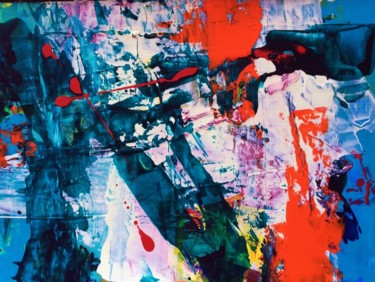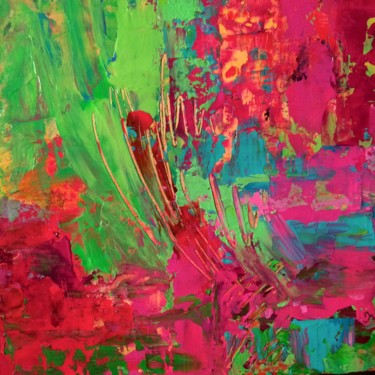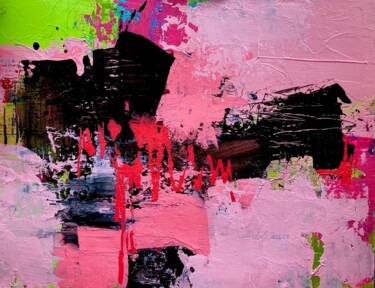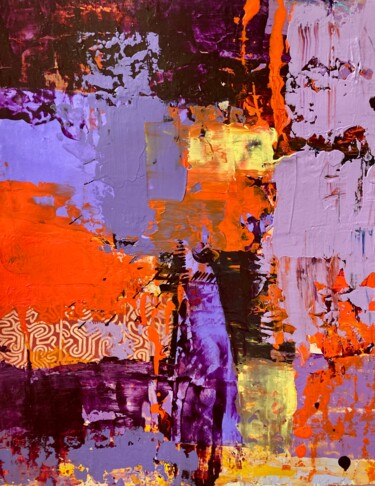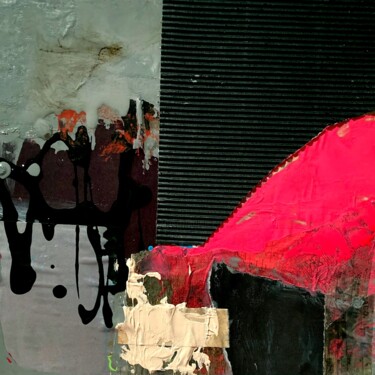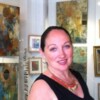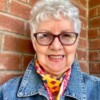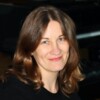Diane Leon
DIANE LEON was born on December 17, 1945 in New York City. Her formal art studies began at The Art Students League, NYC, from 1974-78. She also has studied at the Pratt Graphics Center, The Printmaking Workshop, The National Academy of Design, NYC and Steinhardt School of Culture, Education, and Human Development, advanced color viscosity printmaking classes, NYU. In 1976, Diane spent the summer at a painting school in the Spanish Pyrenees in the small mountain town of Berdun in Huesca, Spain in the Aragon region. She has also traveled to France, Italy, Switzerland, Greece and Morocco.
Education:
Diane has a B.A. from the New York University, School of Professional Studies in art history with honors and M.A. from NYU, Graduate School of Arts and Science, John W. Draper Interdisciplinary Master’s Program in Humanities and Social Thought. Since completion of her master’s degree in 1995, Diane teaches spring semester at NYU, School of Professional Studies as an adjunct associate professor of arts in the Division of Applied Undergraduate Studies. Her courses are: The Fundamentals of Painting and Design and Collage/Mixed Media in the Division of Applied Undergraduate Studies.
Abstraction allows me to be spontaneous. The handling of acrylic paint on canvas, or paper is influenced by nature’s powerful energy and a sense of place. Growing up in NYC and later on traveling in Europe has influenced how I use color and apply paint with a palette knife.
I work with no preconceived idea. How the completed work reveals itself develops with many revisions. As I work the p
Discover contemporary artworks by Diane Leon, browse recent artworks and buy online. Categories: contemporary american artists. Artistic domains: Painting, Collages. Account type: Artist , member since 2019 (Country of origin United States). Buy Diane Leon's latest works on ArtMajeur: Discover great art by contemporary artist Diane Leon. Browse artworks, buy original art or high end prints.

Artist Value, Biography, Artist's studio:
Latest Artworks • 111 artworks
View allSold Artworks • 56 artworks
Recognition
The artist has won prizes and awards
The artist has been published in the media, radio or TV press
The artist's works have been noticed by the editorial staff
The artist is sold in galleries
The artist participates in art shows and fairs
Exercises the profession of artist as a main activity
Biography
DIANE LEON was born on December 17, 1945 in New York City. Her formal art studies began at The Art Students League, NYC, from 1974-78. She also has studied at the Pratt Graphics Center, The Printmaking Workshop, The National Academy of Design, NYC and Steinhardt School of Culture, Education, and Human Development, advanced color viscosity printmaking classes, NYU. In 1976, Diane spent the summer at a painting school in the Spanish Pyrenees in the small mountain town of Berdun in Huesca, Spain in the Aragon region. She has also traveled to France, Italy, Switzerland, Greece and Morocco.
Education:
Diane has a B.A. from the New York University, School of Professional Studies in art history with honors and M.A. from NYU, Graduate School of Arts and Science, John W. Draper Interdisciplinary Master’s Program in Humanities and Social Thought. Since completion of her master’s degree in 1995, Diane teaches spring semester at NYU, School of Professional Studies as an adjunct associate professor of arts in the Division of Applied Undergraduate Studies. Her courses are: The Fundamentals of Painting and Design and Collage/Mixed Media in the Division of Applied Undergraduate Studies.
Abstraction allows me to be spontaneous. The handling of acrylic paint on canvas, or paper is influenced by nature’s powerful energy and a sense of place. Growing up in NYC and later on traveling in Europe has influenced how I use color and apply paint with a palette knife.
I work with no preconceived idea. How the completed work reveals itself develops with many revisions. As I work the p
-
Nationality:
UNITED STATES

- Date of birth : 1945
- Artistic domains: Works by professional artists,
- Groups: Professional Artist Contemporary American Artists

Ongoing and Upcoming art events
Influences
Education
Artist value certified
Galleries & Groups
Presented by Light Space & Time Online Art Gallery
 Light Space & Time Online Art Gallery
(Art gallery, United States)
Light Space & Time Online Art Gallery
(Art gallery, United States)Achievements
Prizes and Awards
Collective Expositions
Permanent Collections
Publications & Press
Solo Expositions
Activity on ArtMajeur
Latest News
All the latest news from contemporary artist Diane Leon
Article by Ann Williams, Theartworldpst.com on DIANE LEON
https://www.theartworldpost.com/diane-leon-abstract-and-collage-artist-extraordinaire/A
DIANE LEON, May 1, 2017 interview with Artist, Franck de Las Mercedes, NY
about.
art.
prints.
All PostsStoriesTextTextoYoung @ ArtNewsletter#VideoBocetoFellow ArtistsFranckMay 1, 201714 min readFellow Artist: Diane Leon, Creating the life she wants
I had the pleasure of meeting Diane at the taping of a documentary on abstract artists in which we both were featured. Since then we’ve been in touch and always following each other’s work and creative process. She’s a friend, a mentor who champions creativity and as you’re about to find out, a brilliant and wise artist with quite a colorful life.


How long have you been painting?
I have always created art from my childhood growing up in New York City. When I was in my early teens, I saw a Van Gogh exhibition with my father at the Guggenheim Museum. As we walked home along Fifth Avenue I felt drained and overwhelmed. When I started to think about the paintings, it hit me. Van Gogh’s brushwork and colors affected me emotionally. It was then that I realized art would always be a part of my life.
When did you become aware that you were an artist?
At the age of 17, I received what I wanted most for my high school graduation gift. A box of oil paints, brushes and a couple of canvas boards. In high school they had an art class, but because I needed other courses to graduate I was not permitted to register for the oil painting class. I knew then I would teach myself how to paint and never let any person stop me from creating.
What was it like working in the music industry, how did you get there and did you promote or sell your work?
I have always been very independent. In 1964 I was 18 years old, and told my parents I was going to be an artist. I moved out of their apartment and got a studio apt in NYC. I also had a dog and cat to keep me company. I began to work in the music industry because to me it made the office job bearable. It was a better fit for me. I was lucky to have good secretarial skills, (shorthand and typing) which was what you needed at that time. I began at the American Guild of Variety Artists (AGVA) on Broadway in NYC in the legal immigration department. I worked with lawyers and assisted in preparing the visas for the Beatles and Rolling Stones to come to America. When I watched the Beatles perform on the Ed Sullivan Show I was so excited to know I was a part of that event happening. My boss also gave me free tickets to take my sisters and cousins to see them at Shea Stadium in 1966. During this period I showed people at work my art and did commissions. I was so thrilled to paint images of cats, dogs, flowers, their homes, still life and landscapes. In 1969 I had my first exhibition at the Harlem Theatre Arts Building and sold my first landscape at a show. It was a great feeling. I continued to work in the music industry and moved on to booking agencies that handled all the top rock ’n’ roll icons we look back upon today. As a secretary/administrative assistant I handled all the correspondence, and keeping track of all the gigs, accounting, and schedules of the acts. We booked the original Woodstock in 1969, and rock artists such as, Kiss, Allman Brothers Band, ZZ Top, Aerosmith, Joe Cocker, Deep Purple, etc. I also worked and sold my paintings at booking agency that handled all the great soul artists of that time: Aretha Franklin, Erma Franklin and Carolyn Franklin, Wilson Picket, The Staple Singers, Graham Central Station, The Dells, The Delfonics, Earth, Wind and Fire, Teddy Pendergrass, etc. Some of those arts sales paid my way to Europe. The last job I had in the industry was Arista Records. Clive Davis was the founder and president. I worked with his vice president and directly with him when his assistant was on vacation or away from her desk. I had slides in my desk draw and anytime people came up I showed them my work. I also invited everyone to all the exhibitions I had and sold a lot of work. Arista Records was a great place to work. Mr. Davis had an Arista anniversary party at the famous Studio 54. All the pop icons were there and being young at that time made it easy to dance all night and still get to work the next day.
At that time my painting style was realistic and I painted landscapes. I sold a lot of work in oils, pastels and watercolors. Spain has been a passion of mine since 1970 when I bought a place on the Costa Blanca region. I organized an exhibition and with the work I sold I made enough to put down a deposit. I knew when I made that commitment I would always have to work a full time job, unless I was lucky enough to earn enough from my art. By the mid 1970s I could no longer afford to live in Manhattan and moved to Queens. I enrolled at The Art Students League and studied there from 1974–78. I worked right across the street, so it was perfect. All day with the of sex, drugs and rock ’n’ roll characters and from 7–9pm art classes Monday — Thursday and on Friday nights drawing from the model again. It was in 1978, I met my artist husband, John Ferdico. He was in the studio across the hall from me. We dated for a year and in 1979 we got married. We have shared our life and art ever since. My years at the League gave me a solid foundation in basic skills, drawing, painting the figure, glazing, composition that I still use in my abstract work.


When did abstraction pull you in?
Around the mid-1980s I got frustrated with doing my landscapes. I needed a change and decided to go for it and do abstract art. I wanted freedom and have never looked back. Nature is still my primary inspiration, but with abstract art I can use color, palette knife and paint in the moment. When I start a canvas or panel I have no idea where it will go. It comes to life when I begin to compose with color and form. I like using a lot of layering and with acrylic paint it allows me to make the changes I want. My abstract paintings represent memory, and feelings; and have an internal spiritual release for me. I paint almost every night and no matter what else is happening in my life working in the studio is a release for me. Even if I paint for three hours and am disappointed with what I have done, I scrap paint off and start again or just keep working until I resolve that painting. It is all about what I feel at that time. It is an emotional experience for me, not intellectual. Color, texture and form dominate my work. I also prefer working in a small scale. It allows me to work on 2–3 paintings at one time. Also, all my life we have never had a car so painting in an intimate scale made it possible to carry works on the subway, etc. When John and I had were represented in a NYC gallery in the 1990s we used to rent a van and pack up all our work. But, now I prefer to do online juried shows. We have exhibited in Spain; we have work in a gallery in Herefordshire, England called Studio 54. We also have had exhibitions through the Arts in Embassies Program, and was featured in local Queens Courier newspaper article by Marianne Nash, “Queens Artists Work Hang in U.S. Embassies, 2008, In 2009 I was included in The New York Times article, Tight Times Loosen Creativity, by Robin Pogrebin with a photo of myself with a painting by Katie Orlinsky. I received a Special Recognition Award in the online international juried show, “Light, Space and Time,” March 2017, for my abstract work on paper, “Rapture.”
Can you learn from teaching art?
Yes, I have been teaching at New York University, School of Professional Studies, liberal arts degree division since 1995 as an adjunct associate professor of arts. I returned to school in 1986 at 41 years old to get my BA in art history. I also was able to study color viscosity printmaking at the Steinhardt School at NYU and loved it .I then applied to NYU, Graduate School of Arts and Science to work towards a MA in Humanities and Social Thought. I went the academic route because of all the years of basic studio art I already had. I am inspired by my students. I teach only spring semester and my courses are Fundamentals of Painting and Design and alternates with Collage and Mixed Media. Most of my students are not art majors so for many it is a new experience or they have been painting since high school and now want to rekindle their love for painting or collage again. I learn from seeing their enthusiasm. Knowing they can create a work of art and learn the fundamentals inspires me. There is satisfaction in watching them in the creative process and seeing how it develops before your eyes. I am a very positive person and I try to bring out the best in them.


Do changes in seasons and landscape affect or change your work?
Yes, it does. My strongest works seem to be created from late October to June. During that time I love to spend each night painting. By the time late spring comes around I want to spend more time outside and in nature. The summer is traveling around, in NYC and abroad. Years ago John and I used to rent a car, go camping in upstate NY or Pennsylvania, take our art supplies and paint outside. When we travel abroad, we keep supplies in our apartment in Spain. I am always overwhelmed by the beauty of the Mediterranean, mountains, towns, culture, etc. that when I travel I can only do sketch book work or really small works. For some reason it is a spiritual experience and I call it my ‘sitting and staring” time. Just to be in a place like that fills my soul. I need that and that’s why I when I am back in NYC I internalize all the natural beauty. Only then can I start my painting schedule again. In the hot summer I just want to have a gin and tonic, sit under the umbrella by the sea and enjoy the air, watch the waves roll in, and let all my senses absorb what’s around me. In the early fall in NYC I love to enjoy the weather. The elements in nature nourish me in a way to prepare for the oncoming winter.
How big of a role does spirituality play in your art?
For me it is an important role because of my love and admiration for nature. Each day I wake up I thank God for a new day. I love to see the sky, clouds and the trees in the backyard of my building. We have a lot of plants and I am so attached to them. I feel so connected to everything. I was raised a Catholic, but consider myself more of a spiritual person than someone who lives by rules of the church. Painting is a spiritual ritual. It’s one of the only times I can stay so in the moment for hours! As with all artists when you work, that’s all you think about. It is meditative because you really aren’t thinking, at least the way I work. The time stands still because I may think about what colors to put on my palette but in 5 minutes I change it, cover it up and another part of me moves the painting in a completely new direction that did not involve thinking about it. Part of each painting is done on its own. I just make the motions and it seems to paint itself. All artists do that. That’s the beautiful part of the creative process.


Does sharing studio space with your artist/husband pose a challenge at times?
The biggest problem we have is for the past 37 years of never having the luxury of large enough space. Fortunately, we paint at different times. John prefers the day and I have always loved the night. The room that we use as a studio is a small bedroom. John has done some large works and I rework canvases to save the space. It would be impossible to live with all the decades of work we have created. Recently a collector of ours bought a large number of works from us and that made some room. We both held down the full time non art jobs to pay bills, etc. Finally, for me in 2011 I retired from my day job at NYU as a budget administrator. It was a good job, the faculty and students were great. I keep in touch with everyone. I was able to sell a lot of work. My office was filled with my art and it was like a gallery!! I balanced the day job, wrote and published personal essays, exhibited my work, completed school, and taught art after work. Now I continue teaching, and mentoring as a way of giving back. I love being able to work as late as I want in the studio. No longer hate Sunday nights because I have paid my dues and love it!!! When I meet and mentor the graduates from Tisch School of the Arts via the Tisch Industry Network I speak with writers, producers, actors, directors, etc. I let them know that the decisions they make are so important because they can affect the rest of your life. In the arts you need stamina and commitment. You need to realize you have to pay the bills and do what you have to in order to realize your dreams. Be thankful for each day and when things don’t go well; remember “this too shall pass.” Learn to compromise, but make it work in your favor. Whether you are in a small apt and wish you had the space to paint, don’t stop working because you have to paint on the kitchen table (which I did when I lived in a studio apt when I was young) or for the past 37 years share a space with John. Don’t let anything stop you from working.
In a world saturated with imagery can the artist still influence or affect culture?
Yes, an artist can influence and affect culture. Look how music did that when I started working in the music industry. It was later called the Cultural Revolution. In art there have been so many styles and movements. As an artist today, we have so many more opportunities to reinvent how we want to express ourselves. In 1992 I had a solo show at LaGuardia Community College in Queens. The work was a series of 17 collages based on what I had seen in Spain after Franco died in 1975. My personal work may not have changed anything in society, but the Spanish culture affect and changed my work. The collage series was called “Post-Franco Spain: A Cultural Transformation.” I reflected back on my own observations and experiences since 1970 and in the 1992 exhibition it gave me the opportunity to delve into another culture and how women were viewed and changed. I wrote a personal essay on my experience in how and why I bought my place in Spain and it was published in Hercirclezine online. I ended up being an arts editor and wrote featured articles about other feminist women artists from 2005–2007 for Hercirclezine. The world around you affects how you live and perceive yourself. What you write or paint is out there and people are then affected by how you see and view the world. It works both ways. We never create in a vacuum. I think art will always affect culture because we absorb things from our environment in so many ways. As artists it has to be expressed and everything makes us more aware of the world around us in our own vision.


What was your worst art exhibit experience?
My experience is not a horror story, but one of miscommunication. The worst art exhibit experience still stays in my memory. It was decades ago at the National Arts Club in Gramercy Park. It was a large exhibition of watercolor paintings. I had never received notice of a rejection or acceptance. These were the days before computers, cell phone or texts. Finally on the day of the opening I phoned again and they still could not give me an answer. They advised I just come to the show and maybe I would see my work. I asked if they could see if my name was on the brochure and they couldn’t do that. So, I figured why not, let me look and hopefully be surprised and see my landscape watercolor hanging and enjoy the show. If not someone could hand me my painting back. Well, I walked in and the place was packed. I slowly looked at the show and my painting was not hung. I quietly walked over to some woman who was at a desk and explained my situation and she stands up and yelled across the entire room, so loud it silenced the entire room; and said to another person , “Can you find the rejected painting for Diane Leon, she’s here to pick it up” That rude bitch!! I was so humiliated the look I gave her I am sure she will never forget. I controlled myself because I am not a shy person and have no problem telling anyone o
Reviews and comments

